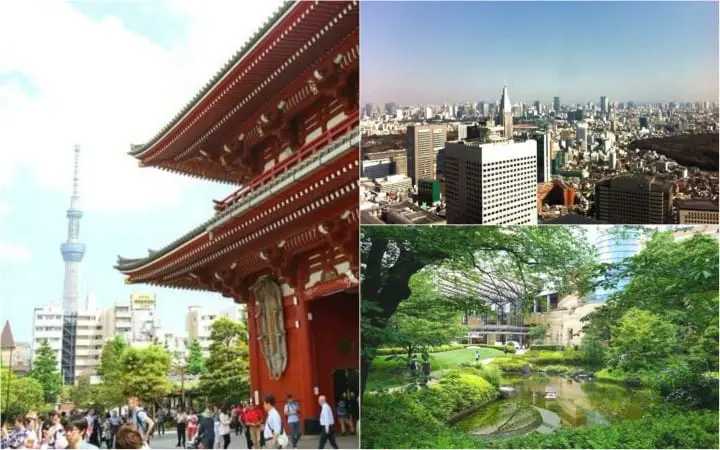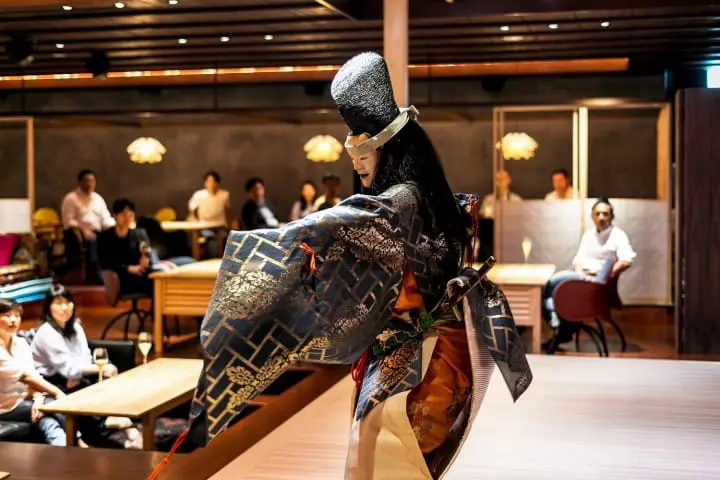Noh Theater In English! SUMIDAGAWA: Sound of prayer cradled in sorrow

Noh theater is a traditional Japanese performing art that can rarely be enjoyed overseas. On Saturday, February 23, 2019, there will be a very special performance of the Noh play “Sumidagawa” with English subtitles and a lecture in Tokyo.
A Stage Art with over 600 Years of History! Enjoy Noh in Tokyo

Noh “Sumidagawa” - Photograph by Ishida Yutaka
Noh is a traditional Japanese performing art that was established in the Muromachi Period (1333-1573). It has been adored by the Japanese through the Edo Period to the present day. Some Noh enthusiasts not only frequent theaters but take utai (Noh chant, *1) or mai (Noh dance) lessons as well.
Among all the traditional performing arts of Japan, Noh can rarely be watched overseas. This is because Noh performances require a certain type of stage that has a roof over it. This stage is one of the features that are unique to Noh.
If you are visiting Japan, how about visiting a local Noh theater? On February 23, 2019 (Saturday), there will be a Noh performance with English subtitles and a short lecture that we highly recommend. A workshop where participants can learn more about voice training in Noh will also be held on that day, and the ticket is moderately priced.
This article introduces this special performance that is ideal for those who will be viewing Noh for the first time.
*1 Utai: Noh chant. The art of narrating a Noh text.
Noh - A Traditional Japanese Performing Art

“Sumidagawa”, performed on March 15, 2015: Photograph by Ishida Yutaka
Noh was created more than 650 years ago, yet it still has a large number of fans and followers.
A specific feature of Noh theater is that most of the titles are based on ancient stories and legends that still live on in the minds of the Japanese. The actors put on Noh masks and don beautiful attire to play the roles of deities, heroes, legendary characters or demons.
There are two types of Noh: mugen Noh (dream Noh) and genzai (present time Noh).
In a typical mugen Noh play, a traveler visits a place of interest, and while talking to a local resident, realizes that that person is the ghost of a legendary character. The ghost appears again in the traveler's dream showing him its real face, relates a story of the past and disappears. In this type of Noh plays, there is a constant wandering between the past and the present, between dream and reality.
On the other hand, genzai Noh plays are about the present. The characters do not look back in time but live in the here and now. This makes it easier for the audience to empathize with them.
“Sumidagawa” is one of the most popular genzai Noh plays. It was written by Motomasa, the eldest son of Zeami, the actor and playwright who developed Noh into the refined art that we can see today.
The script of “Sumidagawa” was adapted into an opera titled "Curlew River" by Benjamin Britten, which has been performed all over the world. On February 23 (Saturday), “Sumidagawa” will be presented with English subtitles and a short lecture in Tokyo.
“Sumidagawa” - A Moving Story with an Universal Appeal

“Sumidagawa”, performed on March 15, 2015: Photograph by Ishida Yutaka
In “Sumidagawa”, a mother wanders the land in search of her child who was taken away by a merchant. She walks all the way from Kyoto to “Sumidagawa”, a river running through the eastern area of present-day Tokyo. While on a boat crossing the river, anxious to see her child, the mother learns from the ferryman that the child died from a disease on the same day a year ago.
Standing at the grave of her child, the distraught mother starts to chant a nenbutsu prayer (*2) hoping to see her child once more. Although the child does appear, the vision fades away as soon as the mother tries to hug it. Finally accepting the death of the child, the mother wanders aimlessly in sorrow.
*2 Nenbutsu: A Buddhist prayer that consists in the invocation of the sacred name of Amitabha.

The prop symbolizing the child's grave. The ghost appears from inside this grave.
“Sumidagawa” is a moving and truly impressive Noh play, and one of its features is how sorrow and loss are expressed.
Of course, the Noh mask worn by the lead actor does not show any expression. Nevertheless, the audience can feel sorrow, hope, despair, and disillusion through the actor's performance.
In Noh, props are often used to help the audience imagine the story. In “Sumidagawa”, there is a prop that symbolizes a grave (shown in the photo above).
This play describes the sorrow of losing something dear, a theme that many people can relate to. This theme may be the reason why “Sumidagawa” has always been one of the most popular plays in the Noh repertory.
Highlights of ‘Noh “SUMIDAGAWA”: Sound of prayer cradled in sorrow’

Takehito Tomoeda (left) and Robert Campbell (right)
The performance of “Sumidagawa” on Saturday, February 23, 2019, features a professional Noh actor and will be delivered with English subtitles. In addition, a short lecture and a workshop will also be held before the play, with English interpretation.
A Fascinating Lecture on “Sumidagawa”
Professor Robert Campbell, a Japanese literature scholar and well-known TV commentator, will hold a 30-minute lecture on Sumidagwa. He will talk about the background of the script, the role played by the nenbutsu prayer in this play, and about how the mother's sorrow is portrayed.
Voice Training Workshop
After the lecture, there will be a 30-minute workshop held by Noh actor Yoko Yamamura. She will explain the basics of abdominal breathing and its use in Noh chant. The participants will also read some lines from the play using this technique, under the guidance of Kita school Noh actors. You will surely marvel at the ability of the actors to deliver the lines clearly in spite of wearing a Noh mask.
Performance of “Sumidagawa”
The play features Kita school Noh actor Takehito Tomoeda as shite (*3). The introductory lecture should help in understanding the play.
*3 Shite: The actor playing the lead role in a Noh performance.
Post-performance Talk
There will also be a 30-minute post-performance talk. Was the vision of the child an illusion, only seen by the mother? Or was it a ghost, summoned by the nenbutsu prayer? These are some of the questions that arise after watching “Sumidagawa”. The expression of sorrow, along with some of the memorable scenes, will also be discussed.
This session should be a good chance for the participants to deepen their understanding of Japanese culture.
Details on Venue, Schedule and Ticket Reservations

The Noh stage of Kita Noh Theater
This special performance of “Sumidagawa” will be held on February 23 (Saturday), 2019, at Kita Noh Theater, which is located near Meguro Station in Tokyo. The venue opens at 12:00 and the introductory lecture starts at 13:00. After the performance, at around 15:30, the audience will be invited to join the post-performance talk (participation is optional).
Tickets can be purchased online or at ticket stores. The price is 3,000 yen (first floor) and 2,500 yen (second floor) for adults, 1,500 yen (first floor) and 1,200 yen (second floor) for students.
Tickets can be reserved online on this website: http://confetti-web.com/Noh-sumidagawa (English support available).
Tickets can also be purchased at Tickets Today stores in Shibuya, Ginza, Omotesando, Asakusa, Shinjuku, Tokyo Tower, Akihabara, Marunouchi Tokyo City, Shinjuku Tourist Information Center, and Keikyu TIC Shinagawa Station.
Noh “SUMIDAGAWA” - Sound of prayer cradled in sorrow - Official Website: http://kita-noh.com/eng-schedule/6452/
"Noh “SUMIDAGAWA” - Sound of prayer" Promotional Video
Other Recommended Traditional Culture Workshops
‘Noh “SUMIDAGAWA”: Sound of prayer cradled in sorrow’ will be hosted by Arts Council Tokyo, which also offers other various traditional culture workshops.
The Engei workshop held at the Edo-Tokyo Museum and the Japanese dance and Nagauta workshops held at the Asakusa Culture Tourist Information Center are recommended for international travelers and foreign residents who wish to experience Japanese culture.
The Engei workshop at Edo-Tokyo Museum gives the participants a chance to traditional kyokugei (acrobatics) such as kasa-mawashi (twirling an object on an umbrella), and kamikiri (traditional paper cutting), acts that are popular in vaudeville shows. The thirty minute workshop is held on Saturdays from 12:30, 14:00 and 16:00, until March 31, 2019. For details, please check this page.
At the Japanese dance workshop, held at the Asakusa Culture Tourist Information Center, an instructor will teach the participants the basics of Nihon buyo, a type of traditional dance. After practicing themselves, the participants will also be able to watch a dance performance by a professional. The one hour workshop will be held on Sundays (*4) from 11:00, 13:00 and 15:00. Please check this page for details and reservations.
At the Nagauta (*5) workshop, the participants learn to play a simple tune on the shamisen. Shamisen is a traditional instrument which is used to accompany Kabuki theater and Ningyo Joruri puppet theater. A hoso-zao (thin neck) shamisen will be used at this workshop. The one hour workshop is held on Sundays (January 20 and February 17, 2019) from 11:30, 13:20 and 15:10. For details and reservations, please refer to this page.
*4 Please note that the Japanese dance workshop will not be held on January 20, February 17 and March 3.
*5 Nagauta: A type of traditional Japanese music played on shamisen.
For more information on the various programs, please check the official website of Arts Council Tokyo Traditional Culture Programs.
Organizer: Arts Council Tokyo (Tokyo Metropolitan Foundation for History and Culture)
Supported by and in cooperation with: Tokyo Metropolitan Government

Written by Ramona Taranu
Sponsored by Arts Council Tokyo
MATCHA's promotional account for corporate and local government advertising. We aim to provide useful information to our readers in an enjoyable manner.

































![[2026] Top 5 Strawberry Picking Spots in Tokushima, Naruto| Farms and Access Guide for January to May](https://resources.matcha-jp.com/resize/720x2000/2025/03/06-227165.webp)



